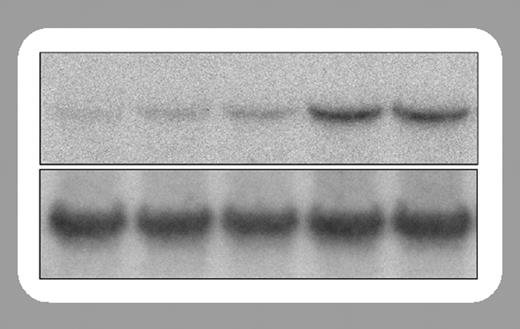HIF is a hypoxia-inducible transcription factor with a remarkably broad physiologic repertoire. It is of special interest to hematologists because research on HIF began with an in-depth study of the regulation of the erythropoietin gene. The identification of a critical response element within a 3′ enhancer, necessary and sufficient for hypoxic induction of erythropoietin expression, led Wang and Semenza to the identification of HIF.1 This heterodimeric transcription factor was shown to bind to homologous response elements in a number of biologically important genes, including those involved in angiogenesis, glycolysis, apoptosis, iron homeostasis, and nitric oxide metabolism. The activation of HIF by hypoxia depends on stabilization of its α subunit under low oxygen tensions. Above a threshold level of oxygen, the protein is degraded by means of hydroxylation of 2 proline residues in the oxygen-dependent degradation domain of HIFα. This posttranslational modification enables HIF-α to bind to von Hippel Lindau protein, an interaction that is necessary for subsequent degradation in the proteasome. This elegant mechanism for oxygen sensing and signal transduction is well understood at the molecular level. However, as the HIF story has unfolded it has become apparent that this transcription factor is activated by a number of other biologic stimuli besides hypoxia. These include insulin, insulin-like growth factors 1 and 2, interleukin-1β, tumor necrosis factor α, and prostaglandin E2. The physiologic significance of most of these alternate inducers of HIF is unclear. In this issue of Blood, Blouin and colleagues (page 1124) present strong evidence for an additional inducer of HIF: lipopolysaccharide (LPS). They demonstrate that LPS can be as robust an inducer of HIF as hypoxia. Moreover, it appears to be cell-specific, with a particularly strong effect in macrophages. It is already known that HIF plays a crucial role in macrophage biology, mediating the enhancement of anaerobic glycolysis that is critical for cellular function. In addition, HIF is required for macrophage motility and engulfment of microorganisms. The stimulation of HIF by LPS, as may occur during the cell's digestion of bacteria, could well provide an additional boost to HIF activation and enhancement of macrophage function. As mentioned above, the primary mechanism by which hypoxia induces HIF is by stabilizing HIF-α. In contrast, a major mode by which LPS induces HIF is by enhancement of transcription of HIF-α. Other inducers of HIF operate by enhancing translation of HIF-α. Thus, there are multiple mechanisms that work independently or in tandem to regulate this critically important transcription factor.
Skip Nav Destination
INSIDE BLOOD|
February 1, 2004
HIF: a paradigm of biologic versatility Free
H. Franklin Bunn
H. Franklin Bunn
Harvard Medical School
Search for other works by this author on:
Blood (2004) 103 (3): 756–757.
Connected Content
This is a related article to:
Hypoxic gene activation by lipopolysaccharide in macrophages: implication of hypoxia-inducible factor 1α
Citation
H. Franklin Bunn; HIF: a paradigm of biologic versatility. Blood 2004; 103 (3): 756–757. doi: https://doi.org/10.1182/blood-2003-11-3815
Download citation file:
February 1 2004
Advertisement intended for health care professionals
Cited By
Advertisement intended for health care professionals


This feature is available to Subscribers Only
Sign In or Create an Account Close Modal